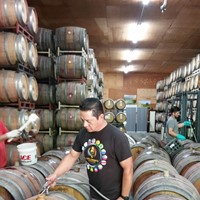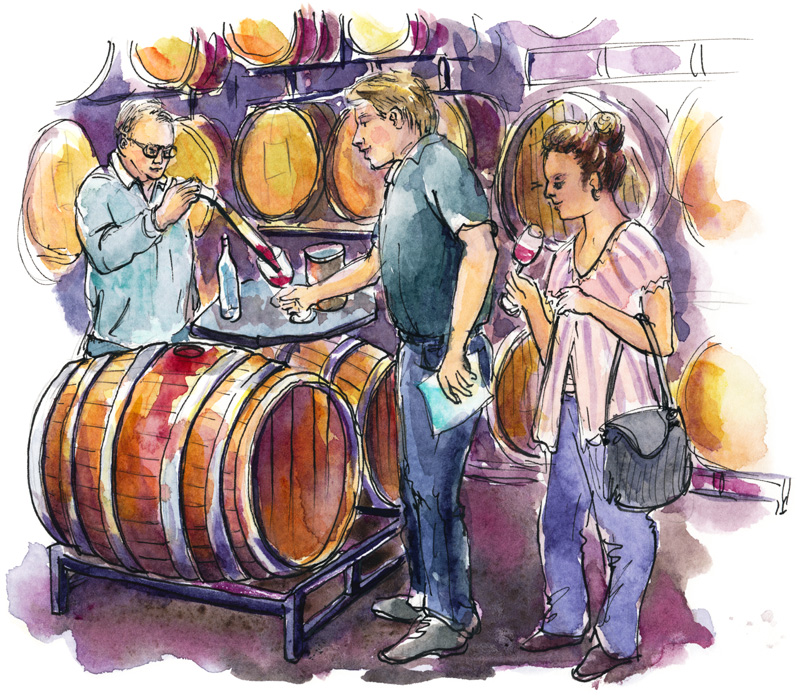Vino In My Dino
Barrel Background
January 24, 2019 10:14

Winter brings our activities inside so the cellar crew is hard at work transferring last year’s vintage, 2017, out of barrel and bringing in the 2018 vintage to rest for a year or more. We also have our site set on Barrel Tasting which is an annual educational event held the first two weekends of March. Join me for a bit of barrel background.
We’ll start with ullage (hint-it’s not a town in Sweden) and it is what happens to wine as it spends time in a bottle or a year in the barrel. Ullage describes the loss of wine due to evaporation while the wine ages. When someone asks me about their 1974 Cabernet and they want to know if it is sound one of the first questions I ask is to describe the fill line on the bottle. The high or low level of the wine in the neck of the bottle tells me if there has been loss over time and possibly determines spoilage because too much air has oxidized the contents. It is the same in a barrel except instead of an ounce of wine lost it is closer to about a gallon every 3 months. The cellar crew helps to prevent oxidation by taking down each and every barrel and topping it off every couple of months. However even at this cost (in wine) the act of barrel aging does concentrate by the slow vaporizing of water and alcohol. Why do you think a barrel room smells so good? It’s all about wine vapor. Oak (and cork) is permeable and ultimately, even though a little air is a good thing, the benefits of concentration and slow development outweigh the loss of product.
The act of ‘thieving’ wine is part of the educational process. Usually the winemaker will taste the young wine while it is heading into the barrel and then, using a wine thief, will check on the progress a few more times during the year as it matures. The wine thief itself, pictured below in a painting by Richard Sheppard, is nothing more than a glass tube for siphoning out a small sample of the wine. During the aging process, as the water and alcohol dissipate, the wine softens little by little, concentrates a bit more. It will take on aspects of the oak as well as loosen up its' grip. If you are trying a wine from the recent harvest be prepared-the tannins are pretty harsh but the silver lining is you get a glimpse of things to come—the fruit components, the acidity, the body—and some of the characteristics will dominate the others. It boils down to a matter of time. Winemakers are a patient lot. Time in the barrel equals a nicely aged wine making it more ready to drink upon release.
Insider tip: You don’t have to become a winemaker to thief wine around these parts (Northern Sonoma County) because we have an event that celebrates Barrel Tasting via the the Wine Road. 40 years ago a few wineries banded together, Pedroncelli included, to market wines made from the Alexander, Dry Creek and Russian River Valleys, to locals and visitors alike. Today guests buy tickets, roam the wine roads, taste young red and white wines and learn more about the process of aging. We usually pair the barrel sample with the current release for comparison’s sake. Sometimes we throw in a library vintage of the same varietal-all in the name of educating one’s palate. Enjoy an insider’s look at wine making by attending and tasting for yourself—the first two weekends of March. It is the focus of aging wine that brings great development and style. Time in the barrel is as important to wine as is the source of grapes.

Categories
- COVID
- Follow the Vineyard
- Note from Home
- PairItWithPed
- Pandemic
- pedroncelli
- Port
- Postcards from Home
- Pruning
- Seasons in The Cellar
- Tasting Room
- Thanksgiving
- Vintage Notes
- Winemaking
- Women's History Month
Recent posts
-
91 Years Later
-
Come Over October: It's About Community
-
Come Over October
-
A Legacy Continues!
-
Everything Old is New Again
Popular tags
- Harvest 2022
- Barrels
- Library Wine
- Lake Sonoma
- Oak
- cooking with wine
- Dry Creek Valley
- note from home
- 1974 Cabernet Sauvignon
- Cellar Master
- Four Grapes Port
- Homecooking
- Seasons in The Cellar
- Pruning
- family
- Easter
- Sauvignon Blanc
- Courage Zinfandel
- Finding Your Roots
- Crop set
- Pedroncelli
- Pandemic
- Habit
- Follow the Vineyard
- Reserve
- Down to Earth
- Sonoma County
- Rosé
- Block 007 Cabernet Sauvignon
- Merlot
- Recipes
- Schotzki
- Pantry
- OpenThatBottleNight
- cheese
- Heat wave
- food and wine
- Bushnell Vineyard
- newsletter
- Cookies
- COVID19
- COVID Coffee Chat
- PairitwithPed
- Estate Vineyard
- Mother Clone
- Anniversary
- American Oak
- Holding steady
- Cabernet Sauvignon
- French Oak





